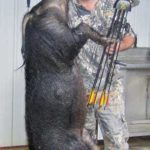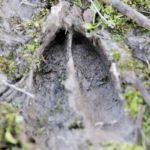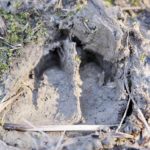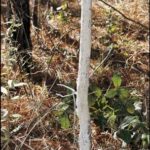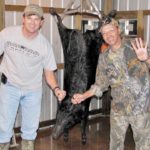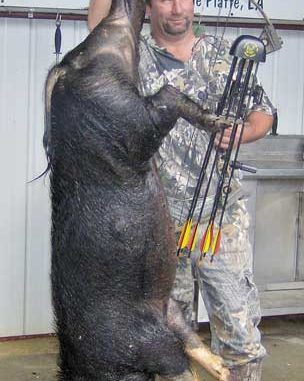
Kill the pigs now, or they’ll kill your hunting land. Here’s what you need to know to put pork chops on your table.
The gestation period for a wild pig is three months, three weeks and three days. Considering that a young sow has eight to 12 piglets with her first litter, and that a sow can have two litters a year, the unfortunate truth is that it’s not a matter of if you’re going to get wild pigs on your property, it’s a matter of when. If a sow has four sows in a litter, and those sows have four sows in a litter, the possibility exists for wild pigs to spread exponentially. And you don’t even have to release them on your property as some have done in the past to get pigs because when their food runs out on somebody else’s property, they’re coming to yours.
The question is, what are you going to do about them when they show up? If you do nothing, you’ll quickly find the hungry invaders have affected your land in such a way that they completely change its appearance, its production and its ability to sustain any wildlife but pigs.
Unfortunately, by the time you realize you have wild pigs on your land, it’s too late to do anything about them other than try to control them because you’re not going to get rid of them. Like a Louisiana lawn that needs cutting week after week during the summer, wild pigs need constant maintenance to keep them under control.
If you think your property is immune to a wild-pig infestation, you need to hear about what happened to Andrew Ahrens, owner of The Lodge at Tee Mamou just south of Basile in Southwest Louisiana. His 1,000-acre hunters’ paradise is full of big bucks, fat cat squirrels and dabbling ducks.
The property is so diverse that a hunter can kill just about any game and catch just about any freshwater fish found in Louisiana. And wild pigs threatened it all before the lodge even opened. Ahrens became a pig expert by necessity, and what he has learned about detecting and controlling these pesky but tasty animals will help anybody who encounters pigs on his property.
“We first discovered we had pigs while my daughter and I were out deer hunting one evening,” Ahrens recalled. “We were hunting over some corn and planted food plots, and a big hog showed up in the plot. We shot it, and excitedly brought it back to the lodge because we had never seen one before. It was a 200-pound boar. It didn’t smell, and it was good-tasting.”
Ahrens’ excitement about the pig quickly turned to anxiety as the one or two pig sightings a year eventually turned into hundreds of pig sightings a year. The first pig sign that he found after shooting that first boar made him realize that he was in for more than what he bargained for.
“We had a gas line that was leaking crude oil, and we thought we might wind up like Jed Clampett, but we weren’t so lucky,” Ahrens said. “The hole kept getting bigger and bigger, and I began to notice hog tracks. Those pigs were rolling in the crude oil. We had the gas company come out and fix the pipe, and the very next night, the pigs dug all that dirt back up to get to it. That’s when I knew I was up against something that didn’t play by normal rules.”
Ahrens began researching wild pigs and asking biologists, game wardens and farmers about what he could do about them. He learned that a wild pig is the most adaptable and smartest animal in the woods. It doesn’t have any natural predators once it gets some size on it, and he wasn’t going to be able to kill or trap all of them.
Knowing that Mother Nature is efficient enough to produce just enough animals in a habitat that a habitat can support, and that wild pigs had no natural predators, Ahrens realized he was the predator that was going to have to control them. If not, they would single-handedly alter his habitat by taking food sources away from deer and squirrels.
“There’s a reason people say to stop being a hog when you’re eating a bunch of food,” Ahrens said. “When a hog gets on a food source, it doesn’t nibble like a deer. Rather, it keeps eating until there is nothing left. That’s going to force your other game to adjust.
“In our instance, we don’t see nearly as many acorns on the ground, and the deer are starting to eat more and more out of the food plots more so than ever before because their natural browse is being eaten up.”
Wild pigs don’t just disrupt game habits, though. Around Basile, sweet potato farmers are loosing acres of their crops when hogs come through their fields rooting them up and taking just one bite out of each one.
Crawfish and rice farmers have to deal with wild hogs busting their levees while rooting around for worms and grubs. There’s a reason their noses are built like spade shovels. And to top it off, they will eat the dead and live crawfish once they burst out the levee.
“A wild pig will eat anything that doesn’t eat him back,” Ahrens quipped. “We noticed last year that they started eating the bark off young pine trees once we quit putting out corn for the deer. And pigs will roam to go where the food is. They’re nomadic, but they stay where there is easy food. As long as that food source is there, the pigs will be there.”
If any of this is causing concern, Ahrens said property owners who are willing to put in the time and effort to control their pig populations will find that their land is able to sustain the wild pigs along with all the other more desirable game. The first step is to figure out if they’re there. The second step is control them through trapping and hunting.
The first signs of wild pigs are usually the wallows that they create when they roll around to coat their bodies with mud in an effort to keep insects off. These muddy holes will have tons of pig tracks all around them seemingly going every which way at once.
Some other telltale signs of wild pigs are mud-caked tree trunks and small saplings and obvious signs of rooting. If you could imagine what a 150-pound armadillo would do to your yard, you’re well on your way to imagining what a pig can do to the ground. They just bury their noses in the ground and throw the dirt up in the air almost like they’re tilling the ground.
“And you can just look for their tracks in obvious areas like watering holes and feeding areas,” Ahrens added. “Once you learn how a pig track differs from a deer track, they are unmistakable. Pig tracks are more rounded and stubby at the tips — kind of like a horse except with the split down the middle of the two toes. Deer tracks are longer and more slender with a point at the tips of the toes.”
If you discover you have pigs on your property, Ahrens said the first obvious thing to do is call the Louisiana Department of Wildlife and Fisheries to get suggestions about your particular situation from biologists. Other than that, you’re only two real options are trapping and hunting them. In fact, using both control methods like Ahrens does will help you better control the population.
Knowing that a pig won’t go into a corner but will follow a circle, Ahrens built a few circular traps that are extremely effective in collecting wild pigs. From above, his traps resemble the No. 6. They are constructed with hog-wire panels with T-posts behind them so the pigs can’t push them in. He leaves one section without a T-post that the pigs will eventually find as they push around the wire trying to get to the corn in the middle. Once they push through the opening, the wire springs back, and the pig can’t escape.
“They do a funny thing at that point,” Ahrens said. “They realize that they are caught, but they accept it and go right back to eating. I guess they figure that they don’t need to move anyway as long as they have food right there in front of them.”
Ahrens tries to leave one pig in the trap while he’s running the traps so other pigs will see it and know that it’s all right to go in. However, the pigs will eventually wise up to the trap and stop going in. That’s when Ahrens moves it to another location, and it’s like the trap is totally new to the pigs at that point.
As to what to do with caught pigs, Ahrens recommended looking into taking them to a slaughterhouse since they are such excellent table fare and everybody seems to want one. He also suggested trying to sell them to individuals at some of the sale barns, some of which may give a dollar or two per pound for them, so they can turn around and sell them to some of the pay-to-hunt places.
While trapping is an effective tool for controlling wild pigs, many property owners will find that they enjoy the other management tool a lot better. Ahrens has learned that hunting over corn with a .270 short-mag rifle out of his box stands is an enjoyable way to control his pig population.
“Hunting pigs is a wild deal,” he said. “I made a perfect shot on a 270-pound boar not too long ago — it was a perfect heart shot — and the pig still ran 100 yards out into a thicket. If you don’t hit them right, you’re really in for a treat. The best shot is a quartering-away shot right behind the shoulder. Besides that, I’ve learned that you can use a really precise .17, .22 or .223, and put a bullet right behind the ear. They’ll drop instantly like that, and you don’t mess any of the meat up like you would with a big rifle.”
Other than hunting with a rifle, some like the ultimate challenge of hunting wild pigs with a bow and arrow. Take Stephen Berzas for example. Berzas, owner of Portable Log Cabins in Mamou, has had the opportunity to archery hunt wild pigs for a few years now, and he has learned that hog hunting is a way he can enjoy bowhunting beyond deer season. In that time, he has picked up a few tips that will help any hunter kill more hogs.
“You’ve got to get that quartering-away shot behind the shoulder blade when you’re throwing an arrow at a pig,” Berzas explained. “The easiest way to get the hog in position is to put out corn in the edges of the woods by a trail rather than right in the middle of where they are walking. This way they have turn their bodies into the woods to eat the corn, which offers you the perfect shot.”
Berzas has also figured out that it doesn’t take more power to kill a hog with an arrow. It just takes more effective use of the power the bow already has. That’s why he prefers to use a Muzzy broadhead that can go through bones. That way, even if he doesn’t get off the perfect shot, there’s a good chance the arrow will still get into the kill zone.
“And elevation is extremely important,” he added. “Pigs have tremendous noses, in some ways better than a deer, and they can sniff you out. That’s why I try to hunt out of a tree stand whenever possible. I learned from experience that those crazy things could also smell you on the corn if you put it out by hand.
“I put out two piles one day not thinking about what I was doing. I put out one by hand, and poured the rest straight out of the bag. Some pigs showed up on the corn, sniffed the first pile, and without touching the first pile they went right over to the second pile and started eating.”
Berzas also explained that attracting pigs to corn is a lot easier if you put the corn where the pigs want to be. Try to find natural feeding areas or places where hogs are going for other reasons like getting water, and put the corn there.
Hunting pigs is growing in popularity every year. It seems like more and more hunters are attracted by the chance of taking down a big, gnarly wild boar with razor-sharp cutters than they are by the chance to take down an elegant and majestic whitetail buck.
“There’s something to be said for taking down an animal seen as a predator rather than prey,” Ahrens said. “And the thing about them is that they’ll eat newborn fawns, they’ll go through turkey nests and anything else that nests or roosts on the ground. So if you don’t kill the predator, you may never get a chance to hunt the prey.”
For more information about hog hunting or any of the other activities offered at The Lodge at Tee Mamou, call 337-432-5353.
